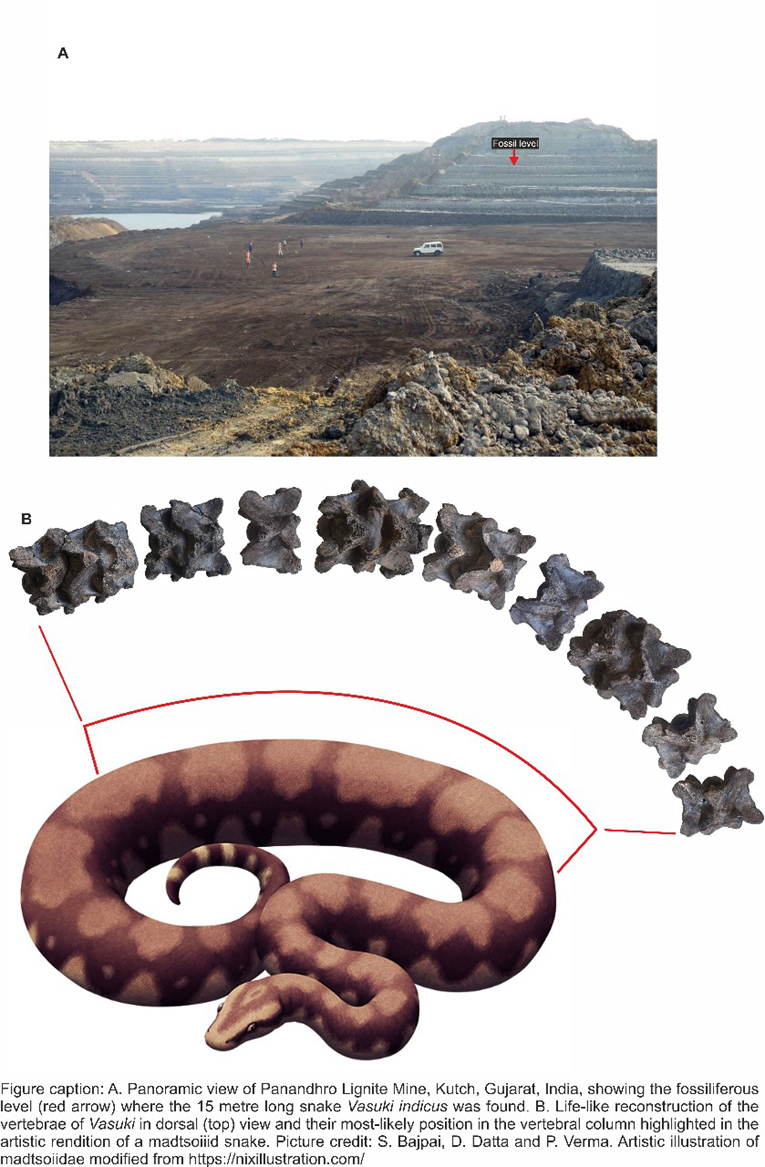INVC NEWS
Roorkee : In a groundbreaking revelation by Professor Sunil Bajpai and post-doctoral fellow Debajit Datta from the esteemed Indian Institute of Technology (IIT), Roorkee, an extraordinary species of snake, believed to be one of the largest ever to
have existed, has been unearthed. This monumental discovery, named Vasuki Indicus, not only adds a significant chapter to the annals of paleontological research but also solidifies IIT Roorkee’s position as a pioneering institution in this field.
Unearthing Vasuki Indicus: A Glimpse into Ancient India’s Biodiversity
The newly identified snake, Vasuki Indicus, thrived in what is now Gujarat approximately 47 million years ago, during the Middle Eocene period. Belonging to the extinct Madtsoiidae snake family, Vasuki Indicus represents a distinctive lineage indigenous to India. This revelation not only expands our understanding of ancient ecosystems but also sheds light on the evolutionary trajectory of snakes on the Indian subcontinent.

Unraveling the Mysteries of Vasuki Indicus
Imagine a serpent stretching as long as a school bus, measuring between 11 to 15 meters! The fossils of this ancient behemoth were discovered in the Panandhro Lignite Mine in Kutch, Gujarat. Among the fossils unearthed, 27 vertebrae were exceptionally well-preserved, with some even found connected or articulated, resembling pieces of a jigsaw puzzle. This intricate preservation provides invaluable insights into the anatomy and morphology of Vasuki Indicus.
Vasuki Indicus: A Formidable Predator of its Time
Analysis of the vertebrae suggests that Vasuki Indicus boasted a broad and cylindrical body, indicative of a robust and powerful build. Similar in size to Titanoboa, the largest snake ever known to have existed, Vasuki Indicus would have been a formidable predator in its ancient ecosystem. Researchers hypothesize that like modern-day anacondas, Vasuki Indicus likely employed stealthy hunting tactics, patiently lying in wait for the opportune moment to ambush its prey.
Vasuki Indicus: A Testament to India’s Rich Cultural Heritage
The nomenclature of Vasuki Indicus pays homage to Vasuki, the mythical serpent often depicted around the neck of the Hindu deity Shiva. This choice of name not only celebrates the snake’s Indian origins but also serves as a tribute to the rich cultural heritage of the region. The discovery of Vasuki Indicus not only enriches our understanding of ancient biodiversity but also highlights the intersection of science and culture.
Prof. Sunil Bajpai’s Insights: Unveiling Ancient Ecosystems
Professor Sunil Bajpai, from the Department of Earth Sciences at IIT Roorkee, emphasizes the significance of this discovery in unraveling the ancient ecosystems of India. He notes that the unveiling of Vasuki Indicus underscores the importance of preserving our natural history and underscores the critical role of research in deciphering the mysteries of our past.
Prof. K.K. Pant’s Perspective: Elevating Scientific Excellence
Professor K.K. Pant, Director of IIT Roorkee, expresses immense pride in this remarkable discovery and underscores IIT Roorkee’s commitment to advancing scientific knowledge. He highlights that the unveiling of Vasuki Indicus exemplifies the institution’s dedication to excellence in research, elevating its stature on the global scientific stage.
IIT Roorkee’s Enduring Legacy in Paleontological Research
This groundbreaking discovery by Professor Sunil Bajpai and his team is part of a broader wave of significant fossil findings in India. IIT Roorkee’s continued contributions to paleontological research reinforce India’s prominence as a hub for substantial discoveries in this field. The uncovering of Vasuki Indicus further cements the institution’s legacy as a leader in paleontological exploration, showcasing India’s pivotal role in advancing scientific knowledge.
In conclusion, the discovery of Vasuki Indicus by IIT Roorkee researchers marks a watershed moment in the realm of paleontological research. This ancient giant snake not only provides insights into India’s prehistoric past but also underscores the country’s rich biodiversity and cultural heritage. As IIT Roorkee continues its quest for scientific excellence, the unveiling of Vasuki Indicus stands as a testament to the institution’s unwavering commitment to advancing knowledge and unraveling the mysteries of our planet’s history.












